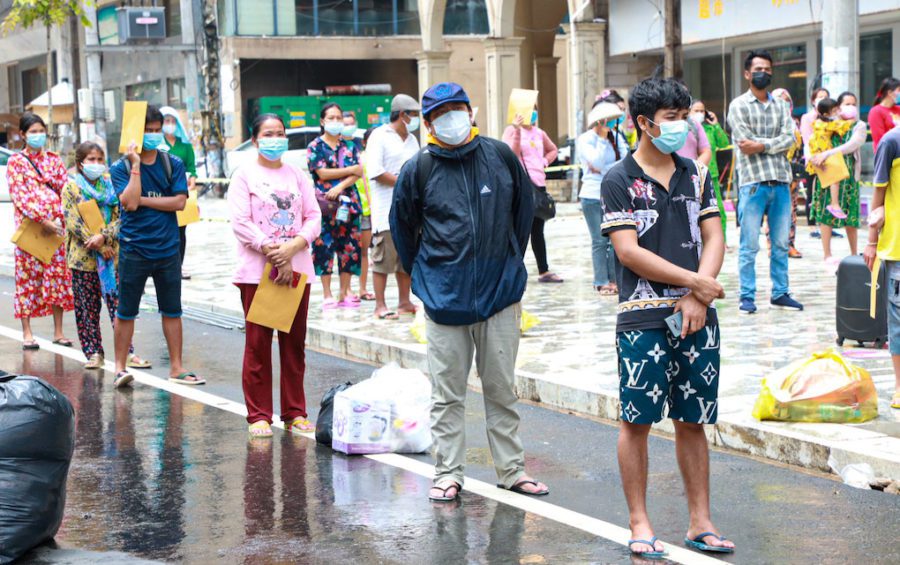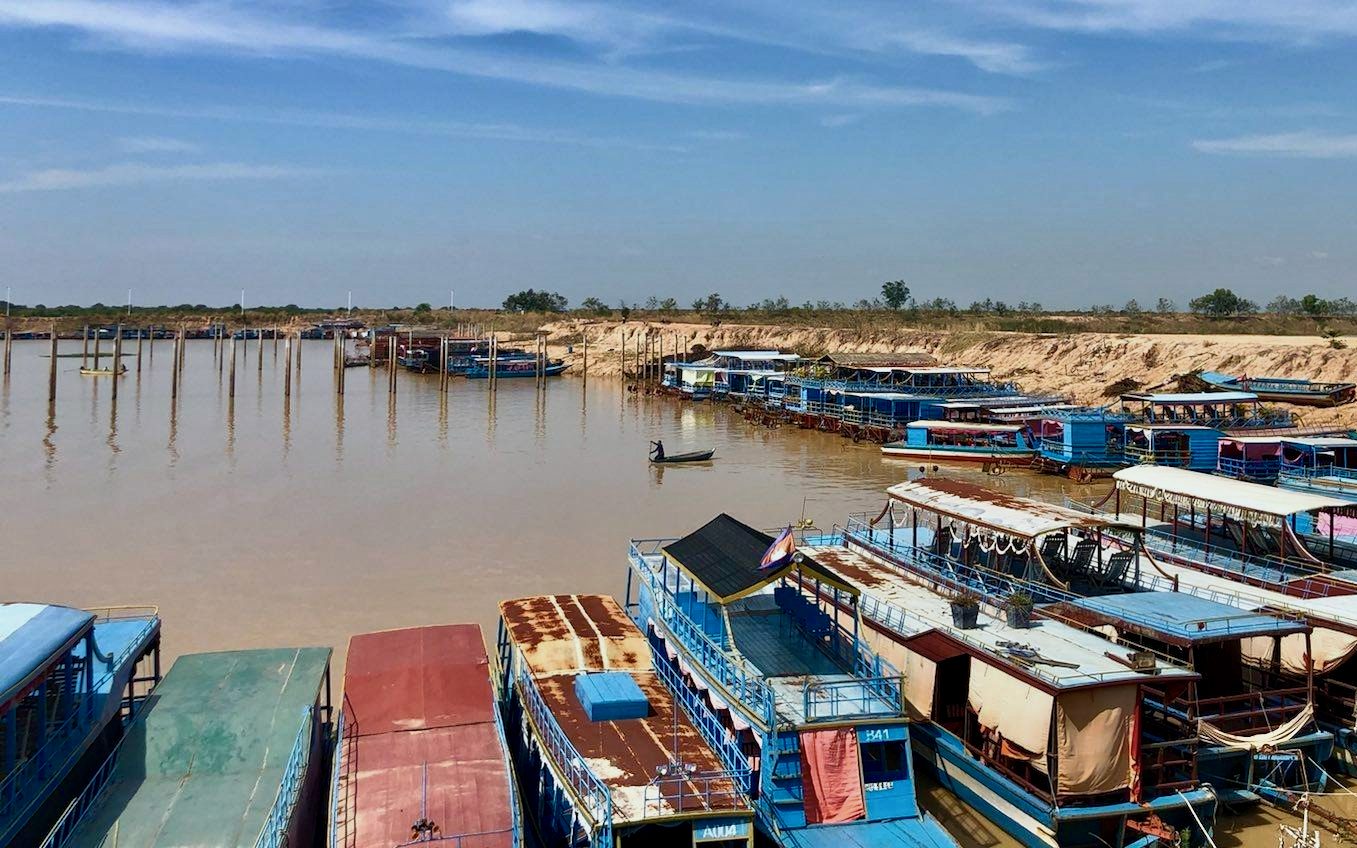Just over a week after Phnom Penh began a widespread easing of Covid-19 restrictions, Preah Sihanouk province has lifted red zones, Prey Veng is publishing photos of people who tested positive with Covid-19, and some provinces appear not to be releasing new infection numbers at all.
Though case numbers appear to be on the decline in some former hotspots — especially in the capital — a nationwide picture is difficult to piece together due to uneven provincial disclosures.
The Health Ministry stopped issuing provincial level data on May 5, and any provincial trends must now be gleaned from 25 different Facebook pages for the local administrations, and not all are issuing reports of new cases.
Kep, Mondulkiri, Preah Vihear and Stung Treng had no posts about new Covid-19 cases over the past week, and it was not immediately clear whether they in fact had no recent cases or they were not disclosing them. Officials at Mondulkiri, Preah Vihear and Stung Treng could not be reached on Friday.
Kandal province also had no posts about new cases — despite an official saying it was seeing dozens of daily cases and currently had nearly 1,400 active cases.
Through May 13, six provinces, excluding Phnom Penh, reported over 50 cases in the prior seven days, led by Preah Sihanouk with a weekly total of 277.
Provinces’ Covid-19 case posts vary in timing — Preah Sihanouk, for instance, posts lists of names that it says are analyzed from the previous day’s cases, while many other provinces list what they say are that day’s cases. It is largely unclear whether the dates refer to the day samples were taken, results recorded or something else.
Pursat province posts a small graphic with a summary of the number of new cases, while many post a table of names and details, and others upload images of documents describing the latest updates. Some updates specify whether positive cases were found through rapid tests or laboratory testing.
Prey Veng, uniquely, posts photo galleries of new Covid-19 patients’ faces. U.N. human rights experts in December said authorities’ decision to allow the publication of personal information about people who had tested positive was alarming, unnecessary and a “deplorable breach of privacy.”
Kandal deputy provincial governor Nov Peng Chandara said the province had recorded 36 new Covid-19 cases on Friday, for a total of 2,251, plus 850 recoveries and six deaths.
His province does not post the data online as it sends its report to the national Health Ministry, and in the past the ministry had disseminated provincial data. He would suggest to the governor about now posting the province’s data directly, Peng Chandara said.
“Just wait and see. I will ask for approval from the provincial [governor] whether we should post it or not.”
Most cases were still part of old clusters, with many family members passing Covid-19 to one another, he said.
Prey Veng deputy governor Chan Tha said it wasn’t local residents testing positive in his province, but people arriving from elsewhere — especially Phnom Penh.
“There have been only people from Phnom Penh returning to their local areas after we opened the gates. We find it after we take their samples,” he said.
The province posts photos of new patients’ faces because they are people who have snuck out from Phnom Penh red zones, Tha said.
“We have to disseminate it to the public to know about it because a red zone in Phnom Penh means being completely closed, but they escaped to the local areas. … It means they don’t cooperate with authorities,” he said.
The province posted of 26 new cases in the week to Thursday. Tha said it had seen a total of 160 positive cases since the start of the outbreak.
Kampong Speu provincial governor Vei Samnang said Covid-19 cases were rising in his province, due to arrivals from a Kandal factory and Phnom Penh’s O’Russei market, both of which have seen outbreaks.
He said it was important for his administration to be posting daily about the new cases.
“We don’t hide. This information must not be hidden, and we must disseminate it to the people so the people can have this basic information to quarantine or take precautions from becoming involved,” he said. “And the people who are involved can know that they need to have a sample taken.”
Local officials were taking advantage of rapid testing, alleviating the need to send samples to Phnom Penh. “It’s just 15 minutes and it shows the result. Before, we used up a lot of time to get results.”
‘No More Red Areas’
Preah Sihanouk provincial administration spokesperson Kheang Phearum said in a message that samples from the coastal province were tested at Phnom Penh’s Pasteur Institute and the National Institute of Public Health.
On May 7 and 8, the province reported 42 and 15 cases, respectively. But on May 9, no new cases were announced due to testing delays, Phearum explained.
“Some results had delays so we carried over to 10 May,” he said. The province reported 95 cases on the 10th.
“We have also been using rapid test kits since mid-April to easily identify positive Covid-19 [patients] and then take their samples for review” at the two Phnom Penh testing facilities, Phearum added.
In the last seven days, the province has seen about 40 cases daily on average, according to statements posted on the provincial hall’s Facebook page.
Asked about whether recent cases were likely transmitted by people staying in the province or those who traveled there, Phearum said transmission in the provincial capital, Sihanoukville, occurred from the “February 20” event, when an outbreak tied to four women who left quarantine without authorization in Phnom Penh began.
Preah Sihanouk began restricting access in and out of the province in early March amid the ongoing outbreak, the nation’s worst to date. Beginning April 23, authorities blocked off Sihanoukville, while five villages in Buon commune were designated “red zones.”
But as of Thursday, red zones in the province were limited to the houses or accommodations of Covid-19 patients, according to a document signed by provincial governor Kuch Chamroeun.
Sihanoukville’s orange zones included three markets and surrounding areas in Muoy commune; part of Village I, a market and surrounding areas in Pi commune; and parts of villages I, II, III, IV and V in Buon commune, the order said.
All of Bei commune and Buon commune’s Village VI are yellow, as are all other areas of the city not designated as orange.
“In the whole of Sihanoukville, there are no more red areas,” Phearum said on Friday.
Still, upon entry to some parts of the city, provincial authorities are checking people’s temperatures, requiring masks and limiting private vehicles to four occupants, the spokesperson said.
Sihanoukville has seen a number of fines and arrests meted out to alleged violators of Covid-19 public health rules.
Phearum said that last week there were “no cases of transitional fines, but there were cases of smuggling from Sihanoukville to Kep.”
A 21-year-old garment factory worker was arrested for fleeing from quarantine in Sihanoukville to Kep, after his factory was shut due to people there testing positive for Covid-19, according to a provincial administration statement dated Thursday. The man was charged for evading quarantine under the Covid-19 Law and faces six months to three years in prison and a fine of 2 million to 10 million riel (about $500 to $2,500).
Phearum said Sihanoukville authorities had written to the Kep provincial governor to find the suspect and hold him accountable under the law.
Nationally, the rate of daily new cases seems to be declining this month as recoveries rise. On Friday, the Health Ministry reported 358 new cases, 348 recoveries and five deaths.
Among the areas seeing a small uptick in cases is Takeo province, where Khun Sea, office chief at the provincial hall, said many of the recent cases were previously infected factory workers transmitting Covid-19 to their parents. The province now had 291 cases, plus 74 recoveries and four deaths, Sea said.
His boss, provincial administrative chief Meas Uy, said the cases were linked to a factory in Prey Kabbas district.
“Just this factory alone, we’ve found 40 cases already,” he said, adding that the number could still rise as testing was ongoing.
He was also concerned that there were other cases in different locations, Uy said.
Nut Sinat, provincial health department director, said 50 further cases had been found on Friday. The latest outbreak was linked to people traveling to Kandal and Phnom Penh for work, he said.
About 6,000 people were in quarantine across the province, he added.
Since Phnom Penh relaxed its lockdown, more people have come home to visit, and those from yellow zones have not quarantined. Sinat added that the province could conduct about 40 laboratory tests per day, plus up to 1,000 rapid tests. If there are more samples, they are sent to Phnom Penh’s Pasteur Institute.
“I think it is not too concerning if we can [maintain] control and people have awareness,” he said. “I believe that people now have a high understanding, and if we look at them, they almost all wear masks.”
Cases in the capital, meanwhile, have been trending down, with Phnom Penh hot-spot districts Meanchey and Pur Senchey recording 21 and 27 cases, respectively, on Thursday. They both saw more than 200 cases in a single day in late April or early May.
Health Ministry health technology department director-general Hok Kimcheng could not be reached for comment.













